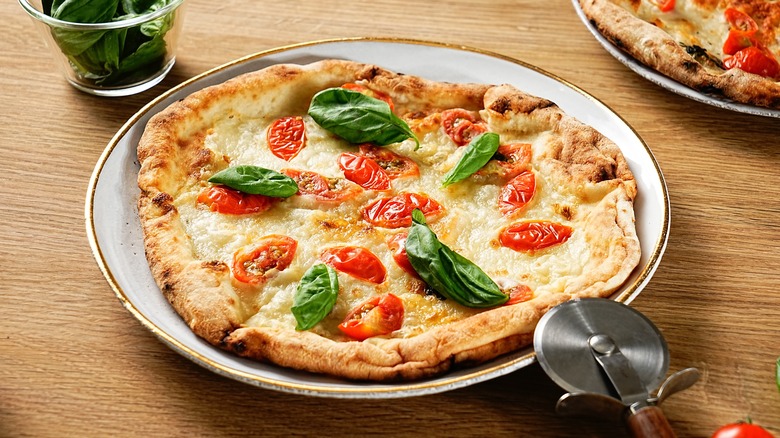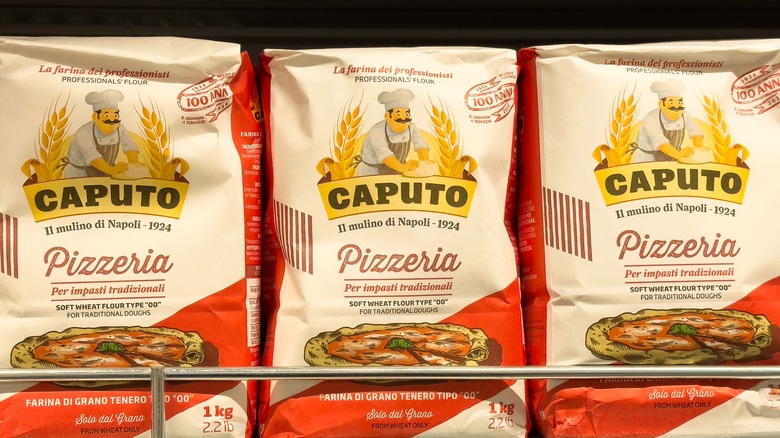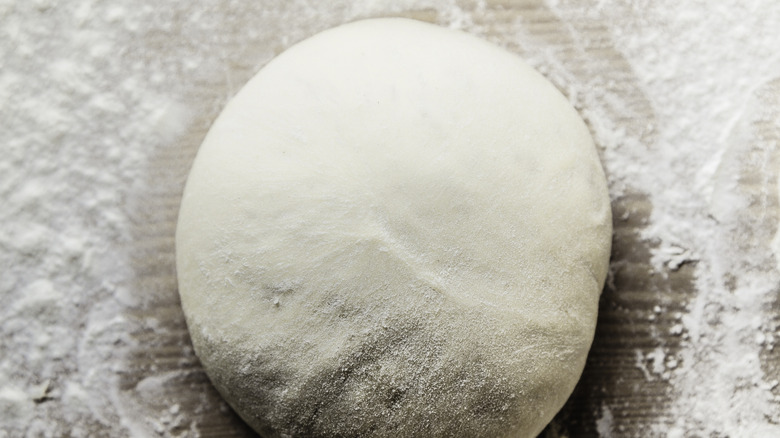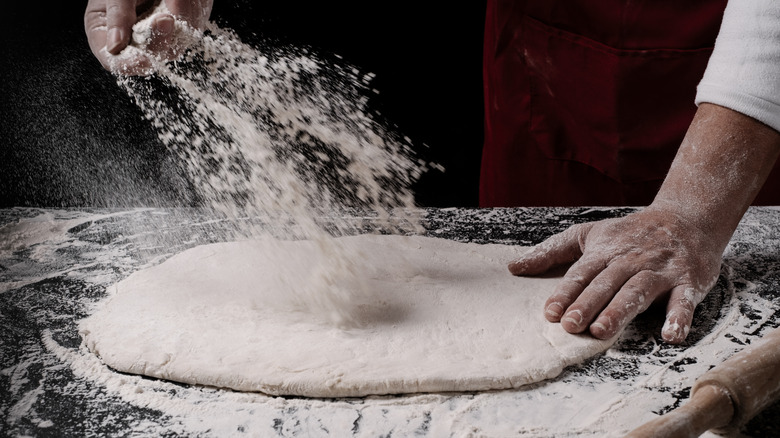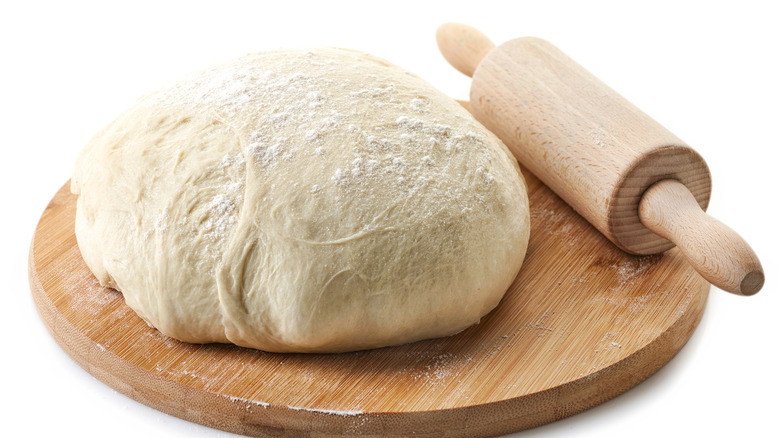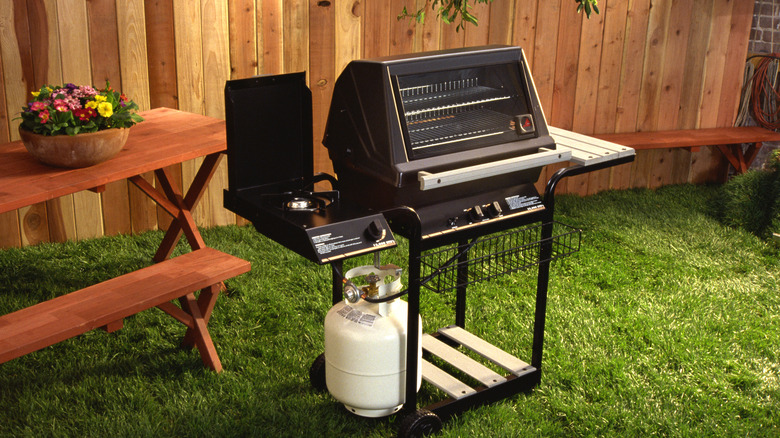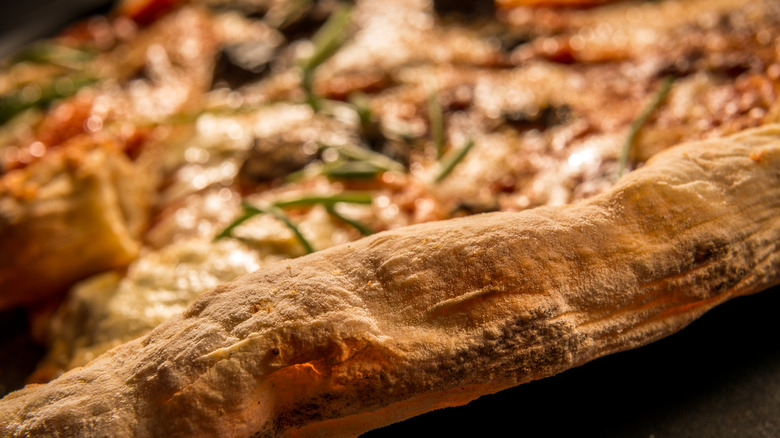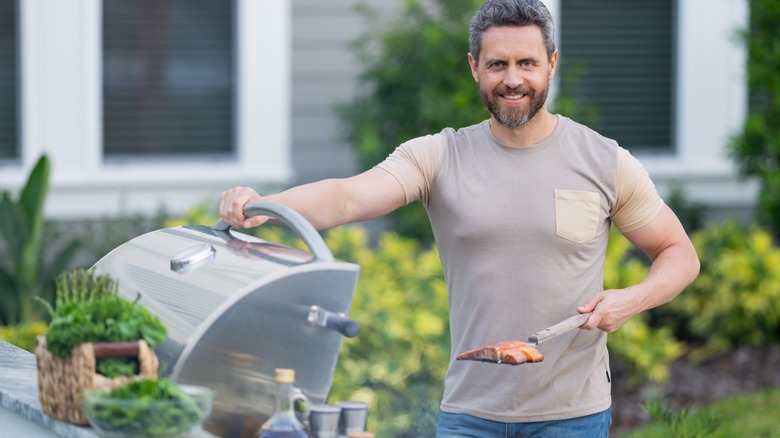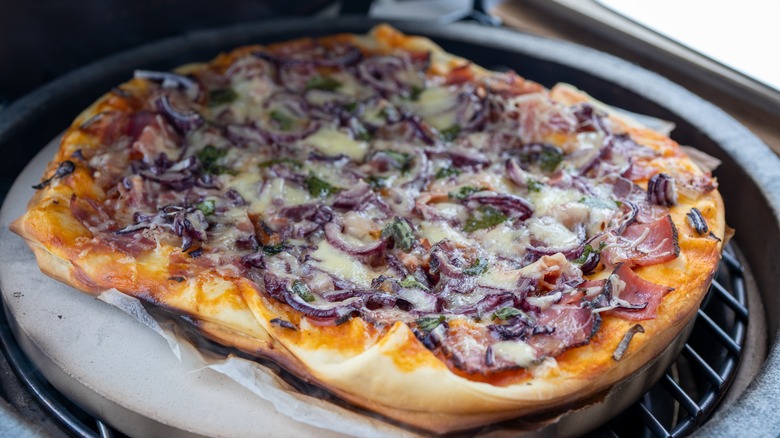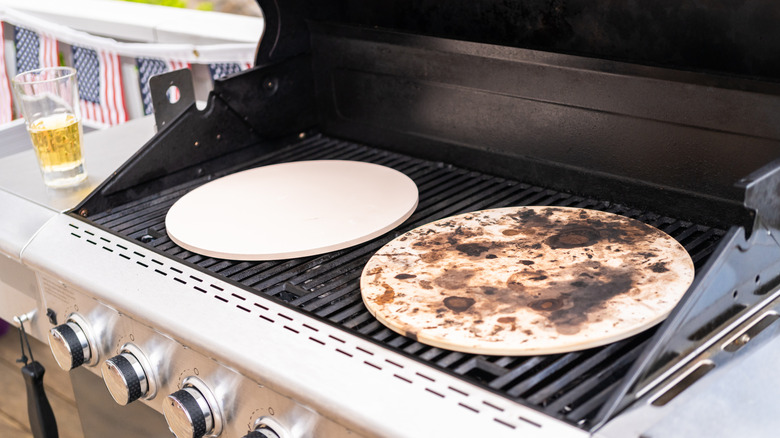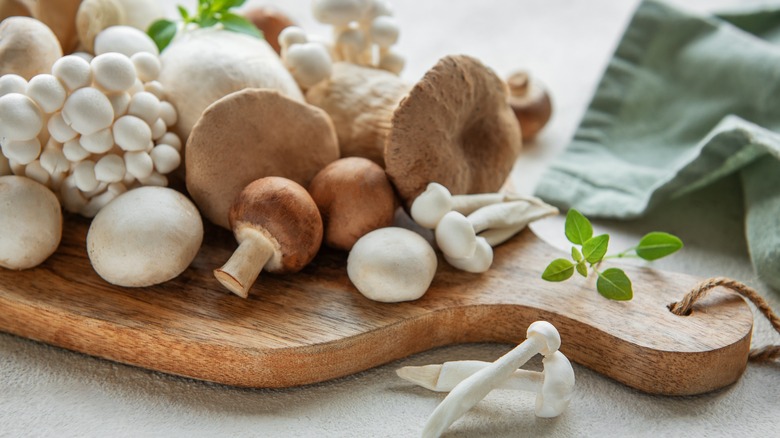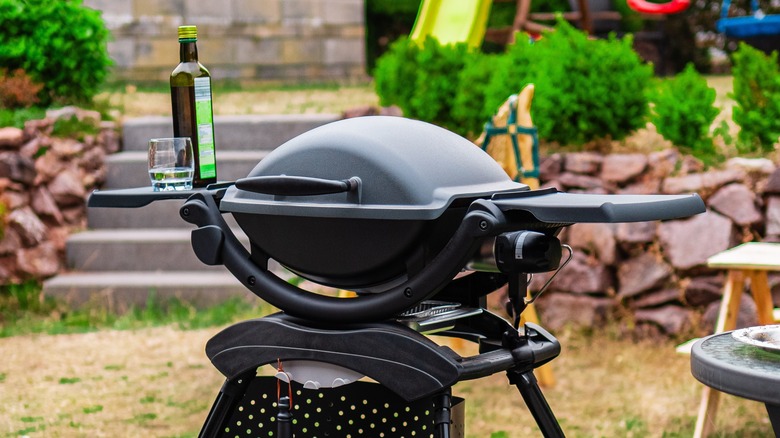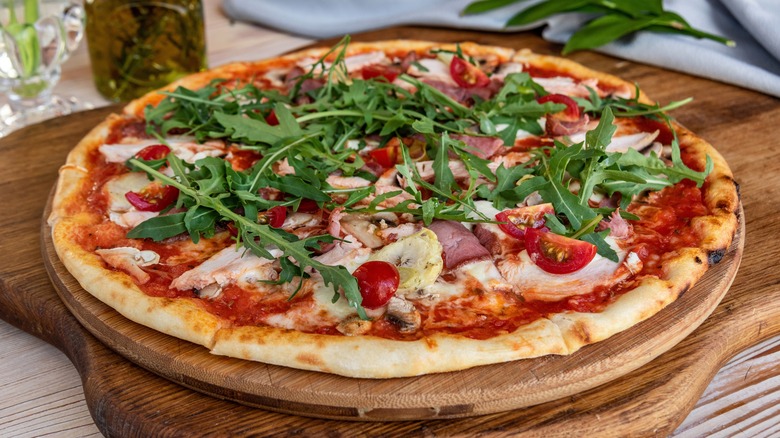14 Mistakes To Avoid When Making Pizza On The Grill
We may receive a commission on purchases made from links.
As the weather warms in the Northern Hemisphere, many eyes start to wander toward the grill. In the last few years, throwing your pizza on the barbecue has become a trend we're only too happy to follow, especially since it gives your pie that smoky taste we all associate with summer, which can only make your pizza taste better. Plus, you don't have to use the oven indoors on scorching days.
While we've shared how to get that perfect crispy crust at home and even tapped into the expertise of chef Anthony Mangieri on the biggest pizza mistakes, there are differences when it comes to grilling pizza. As many benefits as there are to using the good old barbie, there is also plenty of room for error — which is where this roundup of advice from experts who spoke exclusively with Chowhound will come in handy.
"Grilling pizza is a different process than baking it in a home oven, but when done properly, it can yield exceptional results," explains Domenico Tolomeo, corporate chef at Orlando Food Sales, which is the U.S. importer and distributor of Caputo Chef's Flour, a favorite brand for pizza dough. "From the type of flour and hydration level in your dough to your cheese and topping strategy, each element contributes to the final product. When executed with care, grilling can elevate a simple pizza into something truly memorable." Sounds pretty good, no? Time to tackle those mistakes.
Making dough with the wrong flour
Using whatever flour you have in your cupboard as the base for your pizza dough is a mistake. Your grilled pizza is likely to simultaneously scorch and remain doughy. Choosing the right flour is crucial. Jonathan Porter of Chicago Pizza Tours agrees: "We found that a high-protein high-gluten flour was essential. At first, we were doing a 50/50 blend of Caputo 00 and King Arthur Sir Galahad, but we started finding better results making that blend 75% Caputo and 25% King Arthur."
Domenico Tolomeo explains that 00 flours create "a dough that can withstand open flame and higher heat without burning prematurely. They promote even browning, a crisp yet tender crust, and the characteristic light, airy crumb structure ideal for grilled pizza."
In general, it comes down to protein levels. Protein is the structural compound that allows your crust to trap gas and create airy bubbles, says Noel Brohner, a professional pizza consultant at Slow Rise Pizza Co. and a speaker at this year's Pizza City Fest Los Angeles. The higher the protein level, the more gas you can trap. You need a protein content of 12% or higher to get the correct crisp and chewy texture when grilling pizza, says Mark Bello of Pizza School NYC.
Messing up your hydration levels
Next mistake? Failing to understand the complex interplay between water and flour that makes for a good pizza crust. "Hydration refers to the ratio of water to flour in the dough," Domenico Tolomeo says. "When grilling, especially directly on grates, hydration must be carefully managed."
Dough that's too wet will fall between the grill grates, Mark Bello explains, adding that the goal is to have about 60% of the dough be composed of water. That might seem wet, but it is actually the right amount of firmness for pizza dough. Anything over 65% is a mistake. It will get too loose and sticky, leading to sagging, uneven cooking, and burning, Tolomeo says.
It's not too firm, though, which is important. "I'm a fan of big bubbles in pizza dough, so I prefer a wetter, stickier dough," Noel Brohner says. Keep in mind, though, that he's been working with pizza for a long time. "Beginners may want to dial down the water to start and work their way up," he adds. Choose a pizza recipe intended for the grill and for non-experts, and you should be fine.
Of course, if that all sounds like too much for you or if you're simply in a hurry, you can always use one of the better store-bought pizza crusts. Beware, though, that it will not taste the same as making it yourself.
Not warming dough up before grilling
Throwing a cold pizza crust onto a hot grill is another common mistake. No matter how lovingly you choose your flours and pay attention to hydration levels, this will lead to subpar results. Why would your dough be cold in the first place? Because oftentimes, you want to make your dough the night before and let it rest in the fridge. Not only is this more convenient, but it also improves the flavor through a process known as cold-proofing, which gives the yeast and bacteria in your dough more time to metabolize starches.
Instead of using it straight from the fridge, Domenico Tolomeo says, "allow the dough to relax at room temperature just long enough to become workable, then shape it with care." It is very important not to overwarm it, Noel Brohner agrees, explaining, "Overwarming dough is often akin to over-proofing your dough, depending on many factors, including the yeast amount in your dough recipe." If you store your dough in the fridge, he says, give it a few hours to warm up before grilling. A temperature of 60 to 70 degrees Fahrenheit is ideal.
Rolling out, overstretching, or overhandling your dough
Just as you don't want to over-warm your dough, you don't want to over-handle it before it hits the grill, either. This mistake is easy to make but can have devastating consequences for your pizza. "Overhandling dough results in a tough and flat crust," Mark Bello says. "Rolling pins are 'illegal' at Pizza School as they 'choke' the breath of the yeast out of the dough."
Rolling pins aren't the only problem, though. "When dough is overworked through repeated stretching, rolling, or kneading, it leads to excessive gluten development," Domenico Tolomeo says. "This results in a dough that becomes overly tight, elastic, and difficult to shape." That in turn makes your crust too thick, and the tighter gluten make for an undesirably chewy final result. Sayonara, light and airy crust.
If you want to take grilled pizza — or any pizza — seriously, Noel Brohner says, keep a journal. "Take your time and feel the dough as you go. It's constantly changing in good ways and bad so make sure to take note and write down times and temps for future use," he notes. And if you really must use a rolling pin, he adds, do it a few hours before grilling, then coat the dough with olive oil, cover, and let it rise again.
Forgetting to preheat your grill
Forget to turn the grill on in advance and now feel pressured for time? Too bad. Dig out some snacks for your guests and take the time to get it hot because putting pizza on a cold grill is a big mistake.
The thing is, grilling your crust, just like baking it, generally involves a variety of heat sources: direct heat, indirect heat, and ambient heat. "Managing all of these can be tricky at first," Noel Brohner says. "If you want to be successful at making grilled pizzas from the start, choose two heat zones. Medium-high and medium-low is a good start." You will need both when it comes time to cook.
This process is a bit easier to control on a gas grill such as a Char-Broil Performance Series Convective 4-Burner, where you can turn to the desired settings on the right and left. However, you can achieve this effect with an old-fashioned charcoal barbecue like the Weber Original Kettle 22-Inch Charcoal Grill reminiscent of the one your grandparents used. You just have to get the coals hot, then bank them to one side. This effectively creates your medium-high and medium-low zones, but both have to be well-established before you put your pie on.
Not grilling your crust on both sides
Another frequent mistake is to treat your pizza as if you were cooking it in your oven. A grill is different. "You'll generally get better results if you cook the crust on both sides," Noel Brohner says. "The first grilling will establish the most dramatic grill marks on the bottom side and also promote attractive bubbling on the top side, which could be a very positive attribute depending on your personal taste and aesthetic."
The grilling process is simple. Instead of topping and cooking all at once, Mark Bello says, "Our preference is direct on the grill, grilling one side unadorned first. Peel it off and bring it back to your prep table, flip it to top the grilled side, then back on the grill to finish." You can also par-bake it on each side for 1 to 2 minutes, Domenico Tolomeo says, which will create a lightly set structure and prevent the dough from sagging once topped. "Begin your pizza grilling on the medium-high side of the grill and then flip the dough onto the medium-low side to top and finish," Noel Brohner says.
According to Brohner, a large spatula or pizza peel are useful to help you move the pizza around the grill or stone. You can try a Chef Pomodoro Aluminum Metal Pizza Peel, a New Star Foodservice 50295 Restaurant-Grade Wooden Pizza Peel, or a Fox Run Large Oversized Stainless Steel Turner if you need ideas.
Using direct heat
One mistake you don't want to make when using a charcoal grill, or even a gas grill, is to blast your pizza with direct heat, Mark Bello says. On a gas grill, remember to heat one side to medium-high and one to medium-low, so you can avoid blasting your crust at the wrong time. On a charcoal grill, bank the coals to one side to create the two zones.
Or you can create indirect heat by forming a ring around the pizza. "With a charcoal grill you want to arrange the coals around the perimeter and place your pizza in the middle of the grill," Bello says. "This will prevent the bottom of the pizza from becoming overly charred." On the other hand, if you're using a gas grill, "crank up the side burners but leave the ones below the pizza on low." However, he warns, it's not always easy to tell how hot your grill is, and therefore how long you should cook the pizza. "I wait until the crust begins to bubble up and grill lines appear in the dough, about one to three minutes," he shares.
Not combining a grill and a pizza stone
You can grill pizza right on the grate if you want to, enhancing the taste of the final product. However, using a pizza stone is often easier for beginners. "Direct grilling is fun and delivers great char and smokiness, but it's less forgiving," Domenico Tolomeo says. "You have to flip the dough, move quickly, and watch your heat closely. If you're confident working directly on the grates, it can produce an amazing result — but for consistent performance, I stick with the stone." He says it allows you to treat your grill like an outdoor oven — no flipping required. If you don't have one yet, the Hans Grill Pizza Stone gets consistently great reviews.
Pizza stones offer other benefits too, Noel Brohner says. You won't lose ingredients between the grates, you're less likely to burn your crust, and you will have heat distributed more evenly with the stone. You can also combine the techniques. "Start directly on the grill and then flip the dough to top and finish on the pizza stone. This hybrid approach reduces burning and can improve overall results, especially if you are new to pizza grilling." Plus, he says, a stone reduces flare-ups if food falls onto the flames, which you may have to manage with a squirt bottle.
Placing a cold pizza stone on a hot grill
Everything, including using a pizza stone, comes with a price. "The only real downside is that you have to preheat the stone for at least 30 to 40 minutes to get it up to temp," Domenico Tolomeo says, "but it's well worth the wait." You might not think it would matter, but it's a mistake to discount this advice. If you don't heat the stone up first, you risk thermal shock when the cold stone hits the hot grill, which responds to the massive temperature change by fracturing. It might become apparent right then, or it might fully break down the road. Either way, it's a bad idea.
As for temperature, "I like to keep my pizza stone between 450 and 500 degrees Fahrenheit so that the dough has time to finish its final bake slowly," Noel Brohner says. It can be hard to know if the pizza stone is ready, though, so he recommends an infrared temperature gun, which is a hands-off way to register the heat. An inexpensive option such as the Etekcity Infrared Thermometer Temperature Gun 1080 will do the trick.
Undercooking your toppings
A common mistake when grilling pizza is to treat your barbecue like an oven and assume you can throw uncooked toppings onto your dough. However, you might be taking a risk by not precooking some of the toppings. To ensure food safety, you never want to put raw meats atop your pizza. And some other raw ingredients will come out tough and crunchy — or worse, they'll release liquid onto your pie and ruin its texture.
"Because grill times are shorter than in traditional ovens, it's recommended to pre-cook vegetables — such as mushrooms, onions, or peppers — to ensure they are fully cooked and don't release excess moisture onto the dough," Domenico Tolomeo says. Even if they don't release moisture, Mark Bello adds, "the dough is going to cook faster than any ingredients you put on your pizza." To get the best pizza on the grill, precooking is a critical step.
Overtopping your pizza
One of the most common mistakes when cooking pizza on the grill is overtopping. Thin pizza can't hold too many toppings. Even with a thicker pizza crust, less is more. "I think most amateur pizza makers tend to put on too much of each ingredient," Jonathan Porter says. "You have to remember that each ingredient is going to add moisture to your crust."
Ingredients also weigh down the crust, making it difficult for it to rise in those perfect, puffy bubbles that char and crisp so nicely. "A heavy load may also lead to sogginess or structural issues, especially with higher-hydration doughs cooked over an open flame," Domenico Tolomeo says. Keep it light by sprinkling veggies and meats on sparingly. Noel Brohner recommends between one and three toppings max.
Also, avoid the temptation to go crazy with cheese. "For a 12- or 14-inch pie, I use about 3 ounces of sauce and 3 ounces of whole milk, low-moisture shredded mozzarella, or fresh mozzarella," Mark Bello says. If you use fresh mozz, though, he recommends you take care to remove the moisture. He wraps the cheese in plastic and stores it in the fridge for a day.
Not closing the lid on the grill
Closing the lid on the grill is key to creating that ambient heat that thoroughly cooks your pizza and melts the cheese well. "You'll get a better, more well-rounded bake if you experiment with how to best use your grill cover to trap ambient heat and mimic the environment of a pizza oven," Noel Brohner says. It may take a while to hit the right ratio of having the grill lid open or closed, but it's a mistake not to experiment.
"Because grills lack a built-in top heat source like an oven's broiler or dome, closing the lid is crucial," Domenico Tolomeo agrees. So after you've grilled the bottom of the crust or par-baked both sides of the crust, add your toppings and return the pizza to the grill to melt the cheese, crisp the exterior, and puff up the interior. This is key.
Cooking the pizza too long
Another mistake is to leave your pizza cooking on the grill for too long. "Grills, especially gas or charcoal models, can reach much higher temperatures than typical home ovens, often exceeding 700 degrees Fahrenheit," Domenico Tolomeo explains. Such intense heat decreases standard cooking times to between three and five minutes, he says, depending on your dough's hydration and thickness. Also, unlike ovens, grills deliver heat from the bottom.
This intense, direct heat drastically reduces cooking time, often baking a pizza in just 3–5 minutes, depending on thickness and hydration level. In contrast, a standard home oven maxes out around 500 degrees Fahrenheit, requiring a longer bake of 7–12 minutes for similar results. "If not properly managed, this can quickly char or burn the crust," Tolomeo adds. In other words, follow the recipe and keep a watchful eye on your pizza so it doesn't burn.
Leaving the top unfinished
Putting every topping on your pizza before grilling is a mistake. "Using a combination of hot, warm, room-temperature, and even cold toppings to a grilled pizza can add unexpected contrast, texture, and freshness to the expectation of a traditionally hot pizza experience," Noel Brohner says. For instance, whipped goat cheese is a great topping for pizza. He also loves burrata and buffalo mozzarella as well as cured meats such as prosciutto and salami. Pesto and tapenade add a fresh kick, as do pickled onions or black pepper. Think Jeff's Garden Pickled Red Onions or Happy Belly Tellicherry Whole Peppercorns.
Mark Bello, for his part, likes to finish pizzas off with a chef's blowtorch. "This is a great way to make sure your pizza is evenly cooked, and people are entertained by the theatricality of it all." But, he says, keep the torch away from the open grill or tipsy friends. Lastly, if you choose not to flip your crust before topping, Jonathan Porter says, you can finish it off in a salamander broiler instead to melt and brown the cheese nicely.
